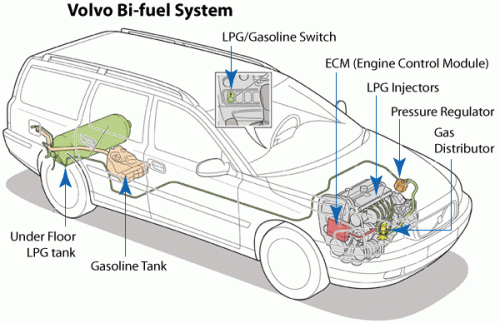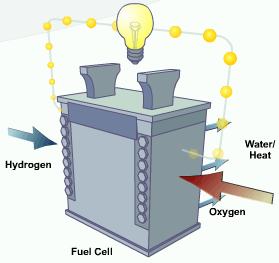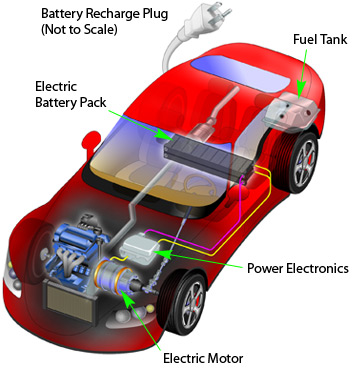What are the types vehicles offering green transportation via alternative fueled or advanced technology?
By:
+David Herron; Date: 2021-01-03T23:53:30.269Z
Tags: Transportation Technology
Electric Vehicles: Electricity can be used as a transportation fuel to power battery electric vehicles (EVs). EVs store electricity in an energy storage device, such as a battery. The electricity powers the vehicle's wheels via an electric motor. EVs have limited energy storage capacity, which must be replenished by plugging into an electrical source.
There are currently no light-duty electric vehicles available from the major auto manufacturers. (this situation is soon to be rectified by several manufacturers) Neighborhood electric vehicles (NEVs), on the other hand, are being manufactured by a variety of companies. These small vehicles are commonly used for neighborhood commuting, light hauling, and delivery. Their use is limited to areas with 35 mph speed limits or for off-road service on college campus or at airports or resort areas. Laws vary from state to state in the U.S. regarding NEV speed and use.
Flexible Fuel Vehicles: Flexible fuel vehicles (FFVs) are capable of operating on gasoline, E85 (85% ethanol, 15% gasoline), or a mixture of both. There are almost 8 million flexible fuel vehicles on U.S. roads today, but many FFV owners don't know their vehicle is one. Unlike natural gas and propane bi-fuel vehicles, flexible fuel vehicles contain one fueling system, which is made up of ethanol compatible components and is set to accommodate the higher oxygen content of E85. E85 should only be used in ethanol-capable FFVs.
Other than fueling capability and ethanol compatible components, FFVs are similar to their conventional gasoline counterparts. Their power, acceleration, payload, and cruise speed are comparable whether running on ethanol or gasoline. The only noticeable difference: fuel economy is lower when FFVs run on ethanol.
Using ethanol as a vehicle fuel provides local and global benefits—reducing emissions of harmful pollutants and greenhouse gases. Ethanol has been blended in low levels (10% or less) with gasoline for many years. This use of ethanol as an "oxygenate" promotes more complete combustion of the fuel, which can reduce exhaust emissions of carbon monoxide—a regulated pollutant harmful to human health—by 20% to 30% compared with pure gasoline.
Natural Gas Vehicles: Compressed natural gas (CNG) and liquefied natural gas (LNG) are considered alternative fuels under the Energy Policy Act of 1992. Natural gas vehicles (NGVs) are either fueled exclusively with CNG or LNG (dedicated NGVs) or are capable of natural gas and gasoline fueling (bi-fuel NGVs).
Natural gas vehicles are fueled with compressed natural gas (CNG) or liquefied natural gas (LNG). Compared with vehicles fueled with conventional diesel and gasoline, NGVs can produce significantly lower amounts of harmful emissions. In addition, some natural gas vehicle owners report service lives two to three years longer than gasoline or diesel vehicles and extended time between required maintenance.
The driving range of NGVs generally is less than that of comparable gasoline- and diesel-fueled vehicles because of the lower energy content of natural gas. Extra storage tanks can increase range, but the additional weight may displace payload capacity. NGV horsepower, acceleration, and cruise speed are comparable with those of an equivalent conventionally fueled vehicle.

Propane Vehicles: Propane is also known as liquefied petroleum gas or LPG. There are more than 270,000 on-road propane vehicles in the United States and more than 10 million worldwide. Many are used in fleets, including light- and heavy-duty trucks, buses, taxicabs, police cars, and rental and delivery vehicles.
The availability of new light-duty original equipment manufacturer propane vehicles has declined in recent years. However, certified installers can economically and reliably retrofit many light-duty vehicles for propane operation. Propane engines and fueling systems are also available for heavy-duty vehicles such as school buses and street sweepers.
Today, most propane vehicles are conversions from gasoline vehicles. Dedicated propane vehicles are designed to run only on propane; bi-fuel propane vehicles have two separate fueling systems that enable the vehicle to use either propane or gasoline.
Propane vehicle power, acceleration, and cruising speed are similar to those of gasoline-powered vehicles. The driving range for bi-fuel vehicles is comparable to that of gasoline vehicles. The range of dedicated gas-injection propane vehicles is generally less than gasoline vehicles because of the 25% lower energy content of propane and lower efficiency of gas-injection propane fuel systems. Extra storage tanks can increase range, but the additional weight displaces payload capacity. Liquid Propane Injection engines, introduced in 2006, promise to deliver fuel economy more comparable to gasoline systems.
Lower maintenance costs are a prime reason behind propane's popularity for use in delivery trucks, taxis, and buses. Propane's high octane rating (104 to 112 compared with 87 to 92 for gasoline) and low carbon and oil contamination characteristics have resulted in documented engine life of up to two times that of gasoline engines. Because the fuel mixture (propane and air) is completely gaseous, cold start problems associated with liquid fuel are eliminated.
Diesel Vehicles (using biodiesel): Advanced diesel vehicles using EPA-mandated ultra-low sulfur diesel (ULSD) fuel are among the most fuel-efficient vehicles available today. Most diesel vehicles also can run on biodiesel blends without engine modification.
Advanced diesel engine technologies combine in-cylinder combustion control for low engine-out emissions with advanced after-treatment technologies and ultra-low sulfur diesel (ULSD) fuel to meet EPA emissions standards. Advanced combustion strategies such as exhaust gas recirculation (EGR) lower engine-out NOx emissions. After-treatment devices such as NOx adsorbers and selective catalytic reduction (SCR), reduce NOx emissions by up to 90 percent. Diesel particulate filters and oxidation catalysts lower particulate matter emissions by over 95 percent. A combination of these after-treament technologies is used to meet stringent emissions standards.
 Fuel Cell Vehicles: Fuel cell vehicles, powered by hydrogen, have the potential to revolutionize our transportation system. They are more efficient than conventional internal combustion engine vehicles and produce no harmful tailpipe exhaust—their only emission is water. Fuel cell vehicles and the hydrogen infrastructure to fuel them are in an early stage of development.
Fuel Cell Vehicles: Fuel cell vehicles, powered by hydrogen, have the potential to revolutionize our transportation system. They are more efficient than conventional internal combustion engine vehicles and produce no harmful tailpipe exhaust—their only emission is water. Fuel cell vehicles and the hydrogen infrastructure to fuel them are in an early stage of development.
Fuel cell vehicles use a completely different propulsion system than conventional vehicles, which can be two to three times more efficient. Unlike conventional vehicles, they produce no harmful exhaust emissions—their only emission is water. Other benefits include increasing U.S. energy security and strengthening the economy.
Like electric vehicles, fuel cell vehicles use electricity to power motors located near the vehicle's wheels. In contrast to electric vehicles, fuel cell vehicles produce their primary electricity using a fuel cell. The fuel cell is powered by filling the fuel tank with hydrogen.
The most common type of fuel cell for vehicle applications is the polymer electrolyte membrane (PEM) fuel cell. In a PEM fuel cell, an electrolyte membrane is sandwiched between a positive electrode (cathode) and a negative electrode (anode). Hydrogen is introduced to the anode and oxygen to the cathode. The hydrogen molecules travel through the membrane to the cathode but not before the membrane strips the electrons off the hydrogen molecules.
The electrons are forced to travel through an external circuit to recombine with the hydrogen ions on the cathode side, where the hydrogen ions, electrons, and oxygen molecules combine to form water. The flow of electrons through the external circuit forms the electrical current needed to power a vehicle. See an animation of the process.
Fuel cell vehicles can be fueled with pure hydrogen gas stored directly on the vehicle or extracted from a secondary fuel—such as methanol, ethanol, or natural gas—that carries hydrogen. These secondary fuels must first be converted into hydrogen gas by an onboard device called a reformer. Fuel cell vehicles fueled with pure hydrogen emit no pollutants, only water and heat. Vehicles that use secondary fuels and a reformer produce only small amounts of air pollutants.
Fuel cell vehicles can be equipped with other advanced technologies to increase efficiency, such as regenerative braking systems, which capture the energy lost during braking and store it in a large battery.
 Hybrid Electric Vehicles: Hybrid electric vehicles (HEVs) combine the benefits of high fuel economy and low emissions with the power, range, and convenience of conventional diesel and gasoline fueling. HEV technologies also have potential to be combined with alternative fuels and fuel cells to provide additional benefits. Future offerings might also include plug-in hybrid electric vehicles.
Hybrid Electric Vehicles: Hybrid electric vehicles (HEVs) combine the benefits of high fuel economy and low emissions with the power, range, and convenience of conventional diesel and gasoline fueling. HEV technologies also have potential to be combined with alternative fuels and fuel cells to provide additional benefits. Future offerings might also include plug-in hybrid electric vehicles.
 Plug-In Hybrid Electric Vehicles: Plug-in hybrid electric vehicles (PHEVs) combine the benefits of pure electric vehicles and hybrid electric vehicles. Like electric vehicles, they plug into the electric grid and can be powered by the stored electricity alone. Like hybrid electric vehicles, they have engines that enable greater driving range and battery recharging.
Plug-In Hybrid Electric Vehicles: Plug-in hybrid electric vehicles (PHEVs) combine the benefits of pure electric vehicles and hybrid electric vehicles. Like electric vehicles, they plug into the electric grid and can be powered by the stored electricity alone. Like hybrid electric vehicles, they have engines that enable greater driving range and battery recharging.
Like hybrid electric vehicles, PHEVs are powered by two energy sources—an energy conversion unit (such as an internal combustion engine or fuel cell) and an energy storage device (usually batteries).
The energy conversion unit can be powered by gasoline, diesel, compressed natural gas, hydrogen, or other fuels. The batteries can be charged by plugging into a standard 110-volt electrical outlet—a capability conventional hybrid electric vehicles do not have—in addition to being charged by the energy conversion unit when needed.
Plug-in hybrid electric vehicles have a larger battery pack than conventional hybrid electric vehicles. During typical daily driving, most of a PHEV's power comes from the stored electricity. For example, a PHEV driver might drive to and from work on all-electric power, plug in the vehicle to charge it at night, and be ready for another all-electric commute in the morning. However, the engine can be used when longer trips are required, and the PHEV does not need to be plugged in to operate.
